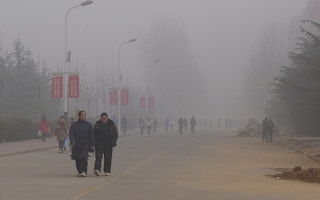In 2014, China declared a war against pollution when Premier Li Keqiang pledged to crackdown on polluters and negligent officials “with an iron fist” at the opening of the annual National People’s Congress (NPC). It was lauded as a landmark shift by the government away from economic growth at all costs to one that recognised the value of environmental protection.
But Li’s tone was quite different at this year’s conference in which he outlined an “employment-first” policy aimed at helping China battle a prolonged economic downturn.
While Li vowed to strengthen efforts on pollution prevention and control, he also said that the government should not only regulate industries according to the law but also hear their “reasonable demands” and “offer support”.
“[We should] allow enterprises a grace period for complying with environmental requirements and avoid simply shutting down factories,” Li told over 3,000 delegates.
Winds of change
The shift comes amid complaints that stringent environmental regulations and blanket restrictions on industrial activities have increased business costs and job losses, particularly at small private companies, a claim the Ministry of Environment and Ecology has refuted.
The economic downtrend has put China’s centralised environmental governance to the test, with Li Ganjie, the minister of environment and ecology, promising at a press conference on Monday to fight negligence on addressing violations and arbitrary production suspensions.
“We will crackdown on the ‘one-size-fits-all’ practices in implementing environmental policies… we will also resolutely oppose relaxing environmental regulations,” Li said.
Li admitted that some local governments were not containing pollution until clean-up deadlines approached or national inspection teams arrived. They have also been imposing blanket production bans on businesses regardless of their environmental performance.
“Such a practice has damaged not only our credibility but also the basic rights of those law-abiding enterprises,” Li said.
The green playbook in question
Li’s comments highlight the limitations of a top-down approach to environmental protection in which central government sets out targets to keep local subordinates in line.
Between 2016 to 2018, China launched two rounds of high-profile environmental inspection that were modelled on the country’s anti-corruption campaign. Led by ministerial-level officials, the central inspection teams visited every province in China, hearing grievances from local people and collecting leads on violations. The inspections aimed to shine a light on local governments that were turning a blind eye to polluting businesses for fear of lowering GDP growth.
The Ministry of Environment and Ecology hailed the campaign as a great success. During the first round between 2016 and 2017 it collected 1.43 billion yuan (US$213 million) in fines from 29,000 enterprises for violating environmental regulations. About 17,000 people from industry and local governments were held accountable, and 1,527 were detained. In 2018, the inspection teams revisited 20 provinces in follow-up checks, levying 920 million yuan (US$137 million) in fines and disciplining over 8,000 people.
Meanwhile, some overzealous local officials tried to boost green performances to impress their bosses without considering the impacts on businesses and the public. The blanket ban on coal heating in the winter of 2017, for example, left thousands of villagers shuddering in the cold.
“
Premier Li’s comment about a ‘grace period’ is like granting immunity for polluters… yet officials will still be held accountable if we fail to meet the targets
Such high-handed practices delivered short-term gains but have yet to translate into long-term environmental compliance. They are set to be further challenged as local environmental officials attempt to rein in polluters without hurting production too much.
“It’ll get a lot harder for local environmental officials this year. Premier Li’s comment about a ‘grace period’ is like granting immunity for polluters… yet officials will still be held accountable if we fail to meet the targets,” Chinese magazine Caijing quoted an anonymous official in northern China as saying.
Environmental gains at risk
In his speech, Premier Li Keqiang asked the country to reduce sulphur dioxide and nitrogen oxide by 3 per cent and further reduce levels of PM2.5 (without specifying the percentage). Sixty billion yuan (US$9 billion) has been allocated from central budget to tackle air, water and soil pollution this year, a 48 per cent hike on last year. Minister Li also promised that the ministry of environment and ecology will offer technological aid for polluting enterprises seeking to upgrade their pollution treatment facilities.
If China cannot switch to smarter environmental governance quickly, it may lose its hard-won battle against smog; between 2013 and 2017, PM2.5 levels dropped 40 per cent in the Beijing-Tianjin-Hebei area.
There are already worrying signs. Reuters analysis of official monitoring data found that between October and February only six of the 39 cities in northern China – in the Beijing-Tianjin-Hebei area and the Fenwei Plain – had registered a drop in PM2.5. Average levels of smog-inducing pollutants rose by 13 per cent to 88 micrograms over the period.
Since the second half of last year, the central government has boosted spending on airports, roads, bridges, rail lines and other infrastructure. China should not return to its “old normal” of relying on smokestack industries – iron, steel and cement – to prop up its economy.
This story originally published by Chinadialogue under a Creative Commons’ License.










